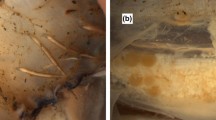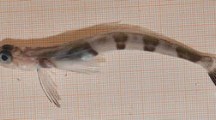Abstract
The endemic New Zealand echinoid, Evechinus chloroticus (Valenciennes), was sampled approximately monthly from September 1990 to October 1994 at three sites in Tory Channel, Marlborough Sounds, New Zealand. These channel sites (outer, mid and inner) were up to 20 km from the open ocean and differed in their shore type, exposure to wave action and macrophyte abundance. E. chloroticus showed an annual reproductive cycle at each site, with gametogenesis commencing in the late austral winter and spawning in summer. Maximum gonad indices (reproductive potential) varied spatially, with the outer site generally having higher maximum gonad indices than the inner site, and temporally, with maximum gonad indices occurring earlier in 3 of the 4 seasons at the outer site than the inner site. The mid and inner sites showed much greater variation in maximum gonad indices (range 15.83 to 26.99% and 11.87 to 20.90%, respectively) than the outer site (range 19.31 to 22.95%). Reproductive output (weight of gametes released per gram echinoid) also varied, with the different sites showing significantly different outputs in the different years. A regression of maximum reproductive potential against reproductive output was significant ( p < 0.001), and had a positive slope with an r 2 of 0.79. While, the initiation of gametogenesis was relatively synchronous between sites and years, and is possibly cued by increasing daylength, it progressed at different rates among populations. Spawning did show spatial and temporal variability, occurring near the time of highest sea-surface temperatures (∼15 °C). The observed variations in reproductive cycle may be related to small-scale variability in diet and environmental conditions. Furthermore, asynchronous spawning, variable spawning duration, and variable reproductive output are likely to strongly influence annual recruitment variability in E. chloroticus, with different larval subpopulations contributing unequally in different years. The ecological consequences of this, both for the ability of E. chloroticus to propagate itself in space and time and for the management of the developing E. chloroticus fishery in New Zealand, are discussed.
Similar content being viewed by others
Author information
Authors and Affiliations
Additional information
Received: 9 December 1998 / Accepted: 13 June 2000
Rights and permissions
About this article
Cite this article
Brewin, P., Lamare, M., Keogh, J. et al. Reproductive variability over a four-year period in the sea urchin Evechinus chloroticus (Echinoidea: Echinodermata) from differing habitats in New Zealand. Marine Biology 137, 543–557 (2000). https://doi.org/10.1007/s002270000366
Issue Date:
DOI: https://doi.org/10.1007/s002270000366




